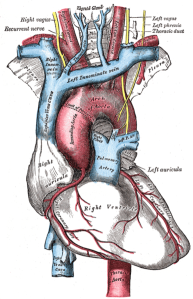 The vagus nerve, the tenth cranial nerve, is really fascinating when you understand everything within the body that it is involved in. It runs from your brainstem down the whole length of the spine to the abdominal organs and innervates every organ along the way. It plays a major role in lowering the heart rate, breathing patterns, intestinal movement, sweating, and speech. It is your bodies off switch when feeling anxious and dealing with an overwhelming amount of stress, and the counterbalance to the fight or flight response. In another post I will talk about its connection to the enteric nervous system, our bodies "second brain", where our serotonin is secreted, packaged, and sent up to the brain via the vagus nerve.
The vagus nerve, the tenth cranial nerve, is really fascinating when you understand everything within the body that it is involved in. It runs from your brainstem down the whole length of the spine to the abdominal organs and innervates every organ along the way. It plays a major role in lowering the heart rate, breathing patterns, intestinal movement, sweating, and speech. It is your bodies off switch when feeling anxious and dealing with an overwhelming amount of stress, and the counterbalance to the fight or flight response. In another post I will talk about its connection to the enteric nervous system, our bodies "second brain", where our serotonin is secreted, packaged, and sent up to the brain via the vagus nerve. If you don't already know, serotonin is that magical substance that travels from the digestive tract to the pineal gland making you feel good, helping you learn, and fall asleep (among many other things). Some cells even use serotonin as a growth factor, meaning it could play a role in wound healing as well. Another neurotransmitter secreted by this nerve was first proven in 1921, when a German physiologist named Otto Loewi discovered that stimulating the vagus nerve caused a reduction of blood pressure and heart rate by triggering the release of what he called "Vagusstoff" (German for: "Vagus Substance"). This was later identified as acetylcholine and became the first neurotransmitter identified by scientists.
By deep breathing, you activate the vagus nerve and bring balance between your parasympathetic and sympathetic nervous system; major stimulation occurs during exhalation. There are many different patterns of breathing that you can incorporate into your daily practice which I will go into more detail at a later time. But, my current favorite is the "whistling breath" which stimulates the vagus nerve through the action of the lips, as well as the glandular system to aid in relaxation. Sitting in an easy pose (chair, lotus, cross-legged), inhale slowly through puckered lips and focus on the sound, using the same technique on the exhale. You can alternate between a whistling inhale and exhale through the nose or vise-versa. There is no time limit but attempt this for several minutes and pause to notice the changes in your body. Always resume normal breathing patterns if you get dizzy or lightheaded. For me, this breath is extremely energizing yet relaxing at the same time.
Now, if you have dabbled in the seven main chakras and kundalini you can see why the vagus nerve is often the modern link to this spiritual energy. This is a major nerve carrying serotonin, dopamine, and acetylcholine from the base chakra and wandering up the spine while touching each chakra along the way until it hits the pineal gland. It is said that ancient yogis were able to slow the heart until it appears to stop and their respirations as if they are not breathing.
No comments:
Post a Comment